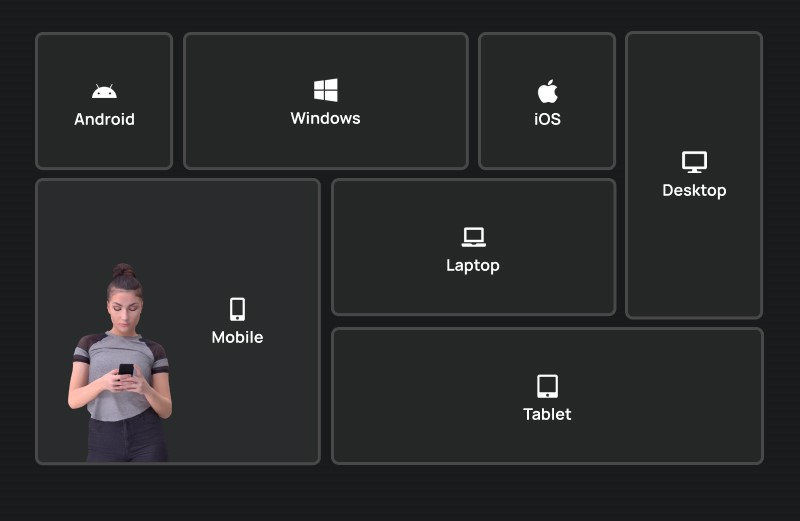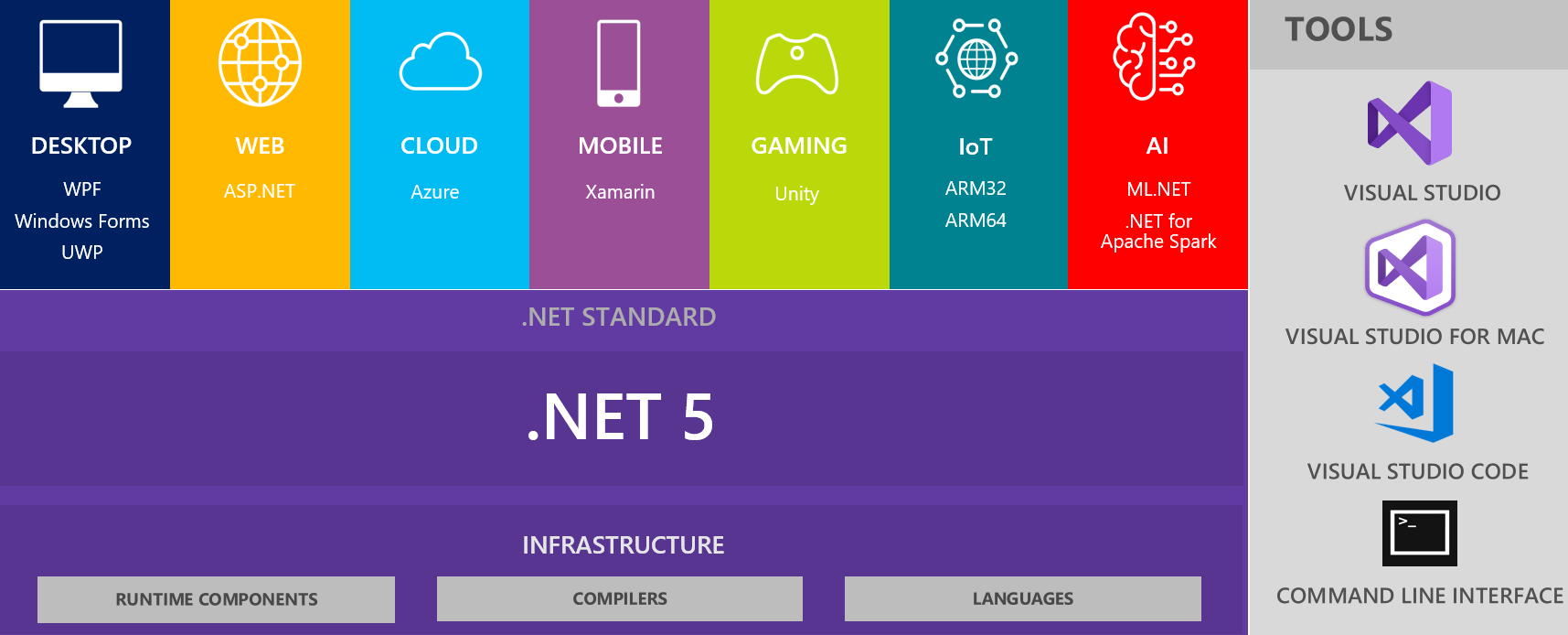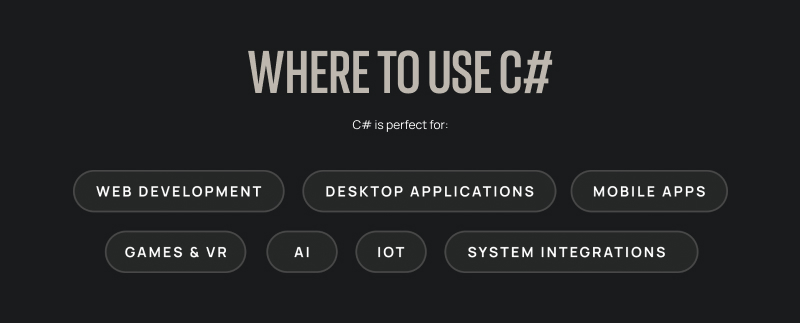How to select the right software services provider?
- July 25
- 28 min

For business, explaining what a software development tool is, is often insufficient. To bridge the gap, the business side needs a justification of “Why” one relies on a particular tool. In this piece, we provide the “Why” to help better understand the rationale behind the popularity of .NET and C# software development among industries. To get to the core, we need to start with the fundamentals.
.NET (dot NET) is a platform developed by Microsoft for developers to build all kinds of applications – web, mobile, desktop, games, IoT, cloud, AI, microservices – you name it. For Android, Apple, Linux, and Windows. It is a free, open-source, and cross-platform programming environment with tools and libraries for most software development phases. With its architecture and features, as well as its continuing development, .NET is becoming the go-to software development tool for answering today’s and tomorrow’s modern challenges.
To understand the current state of modern software development it’s worth taking a step back to the origins and context of the tech shift. The conventional event branding this change is the introduction of the iPhone to the world in 2007. Nevertheless, the technological transition is an evolutionary road not an overnight event.
The beyond desktop era has entered the business, requiring a constructive re-thinking of the approach to software development. To become responsive, the desktop exclusive software needed a decay and steady set up for commercial efficiency. The question of overcoming the tech debt and meeting the demands of the modern world was echoing with growing frequency.
Innovation, or digital transformation, has proceeded quickly and across multiple domains. New expert services offering better adaptation to rapid change have been earning greater recognition. Mapping business areas for improvement and shaping solutions with technology has enriched the software development process. With technological upgrades, businesses earned better performance. At the same time, more emphasis was given to digital information security of systems and data privacy.
On the one hand, the business side had to respond adequately to modern realities; on the other hand, software development had to be fast, performant and secure. Common core components, libraries, and patterns have become an integral part of high-speed software development. Technologies themselves have also evolved. As mutually propelling – the business and technology – aimed to provide greater and speedier connectivity.
How to overcome tech debt, respond to market demands and future-proof the business remained a challenge. Short-term fixes are one thing (necessary, although time-consuming), but a software architecture that enables rapid deployments while maintaining the highest security standards has become a strategic focus for the technology world.
The first version of .NET was a framework dedicated to software development for Windows, released in 2002. As technology and social behaviors have been evolving, Microsoft was successively developing the platform.
To better outline the context of the avalanche of changes that have taken place, let’s one more time jump into 2007.

A breakthrough year when everything was reinvented. In 2007 Facebook went global, iPhone was introduced to the world, and the first code was committed to GitHub. The list goes on, Twitter, Kindle, Android, and IBM’s AI-powered system Watson went public, and Airbnb was founded. It was also the time when public cloud computing emerged (Amazon Web Services started in 2006). Eventually, an API course was formed and microservices emerged as a response to a more agile approach to developing software architecture.
Technology has led to change, and the convenience it provides has made people eager to adopt new behavior patterns and the way they process information. Human interaction models have evolved, the attention span has shortened, and the way of operating business needed to undergo a transformation. Ignorance of innovation has swept several giants out of the market, and others have learned the hard way of returning to the top.
The explosive technological growth was due to the breaking down of the barrier of high entry, processing and storage costs. Cloud computing and more agile approaches to software development have entered the game.
Technology has pushed the change, moved beyond the desktop and faced new challenges such as performance, connectivity, accessibility, adaptability and responsiveness on smaller screens.

The snowball effect of the technological boom generated many opportunities but also made it difficult to keep up with new releases, updates, and implementations. While users became expectant of widespread availability, the technical side faced the challenge of optimal cross-platform software development and delivery.
Observing the shift taking place in the market, Microsoft in 2014 announced a new version of the .NET. The new creation was an exact response to the tech and business demands. The .NET Core was released in 2016 as a new cross-platform, cloud-friendly, and open-source version of the .NET framework. The new environment – Integrated Development Environment – was designed for Windows, Linux, and macOS software development.
The widespread adoption of mobile devices resulted in Microsoft’s strategic acquisition of Xamarin/Mono in 2016. Xamarin/Mono was founded in 2011 as a platform for mobile applications development for iOS, and Android. As it stands now, Xamarin is a free and open-source mobile app platform for building iOS, Android, tvOS, watchOS, macOS, and Windows apps in C#. As a part of .NET, it offers tools and libraries for building native and high-performance applications. The environment allows engineers to share up to 90 percent of code across major platforms.
As a proof of the continued advancement of the .NET ecosystem, .NET MAUI went into general availability in mid-2022. It is the official successor to Xamarin offering an even better developer experience for cross-platform application development.
Although back in 2016 the capabilities of the .NET platform were quite extensive it was still a bit short of the form in which it operates today.
Subsequent years of progress and striving for unification have steered the development of modern software into bundled development platform. In November 2020, the new release of .NET (.NET 5) tied the ecosystem together.

The new release cemented the fragmented world of .NET and provided plenty of features for building applications on Windows, Linux, macOS. The platform comes with new APIs (Application Programming Interfaces), language features and runtime capabilities thereby making it the most favorable and efficient development environment.
For more than a decade, we have been witnessing a technology boom that is changing virtually every aspect of daily life. The self-perpetuating changes have created new challenges for business, among them:
• Overcoming the technology debt,
• Narrowing the mobile gap,
• Processing larger amounts of data,
• Merging sources of information,
• Ensuring cyber security,
• Automating processes,
• Cost optimization and
• Future-proofing software.
The .NET platform is the answer to these and many other challenges that businesses are facing and will continue to face.
Microsoft, by unifying the .NET platform, has introduced a powerful tool for developers that brings tremendous value to business. Especially for companies that want to operate extensively and secure their growth.
The succeeding iterations of .NET provide a unified development environment for building projects for cloud, browser, IoT, mobile and desktop contexts, allowing all to use the same .NET libraries, SDKs and runtime.
It took years to create the .NET platform in its present form. But thanks to that time of learning and development, keeping an eye on global changes, businesses can take advantage of accelerated development without concerns about the security of software products.
The .NET platform is an excellent starting point for platform-agnostic ventures as well as modular project development. The utilization of common code parts means faster project execution, decreased latency time, and memory use.
Less time spent building from scratch means lower cost, faster time-to-market and more space for creative work. At the core of the well-thought-out .NET infrastructure is Common Language Runtime (CLR). It is the beating heart of the .NET platform, the foundation that all .NET applications undergo.
From a technical perspective CLR is a complete, high-level virtual machine designed to support a wide range of programming languages and the collaborative potential between them. It manages memory, implements code access security, verifies code safety, and provides execution of threads and code.
From both a business and project perspective, CLR takes the burden off developers to do the groundwork as well as ensures that the entire environment runs smoothly. The whole development approach in .NET with its developer-friendly environment gives programmers the ability to work more efficiently. It’s kind of like the leap into industrial age only in the world of technology.
C# (C sharp) is one of the three official languages of .NET platform (the others are F#, and Visual Basic). C sharp is a relatively young language, actively supported by Microsoft and the broad community. It was originally released in 2002 and is used in various fields of software development, such as web development, desktop applications, mobile applications, games and VR, AI, IoT, and system integrations.

C# is often described as Microsoft’s modern answer to Java. It was developed out of the need for a solid object-oriented instrument that would allow development of more complex programs, for which the older Visual Basic .NET did not perform well.
C# as one of the extremely versatile and modern programming languages is gaining popularity – 5th according to the TIOBE Index (an indicator of the popularity of programming languages) in mid-2022. The versatility of the C# language combined with the capabilities of the .NET platform create a strong foundation for unrestricted and cross-platform software development under Microsoft’s modern tech stack.
C# with the extensive capabilities of .NET becomes a flexible language that can be used cross-platform. C# can be used to build Windows apps, iOS apps, and Android apps, as well as backend and middle-tier frameworks and libraries. However, several factors contribute to the popularity and favorability of C# among software developers.
The composition of the .NET platform and C#, as well as the comfort of development, makes it an attractive concept to deal with for software talents. Businesses relying on .NET and C# may attract more developers as well as have a broader pool of professionals available on the market.
Combined with the capabilities of .NET platform, C# becomes an excellent completion of modern and highly secure software development for enterprise solutions, large production teams as well as startups and SMEs on the road toward performance and growth.
C#’s remarkable capabilities rely heavily on .NET assets to run on different operating systems or platforms. By itself, it is not that flexible. Hence, the mutually driving power of the .NET platform and the C# language encapsulate their greatness.
While .NET provides all the resources for the language, bare C# code is not as agile.
While C# is not the easiest language to learn on its own, using .NET libraries powers it with extraordinary features for modern and cross-platform development.
.NET and C# power all kinds of industries, to name a few: gaming, Innovative chain companies that seek to gain a competitive advantage and handle multiple facilities, parcel companies, aviation giants, TV industry leaders, digital solutions providers, Life Science, and the list goes on. Companies rely on .NET because it doesn’t limit development opportunities while guaranteeing cybersecurity. Additionally, it powers companies with options to use the dedicated Azure cloud.
You name it. A wide collection of libraries, the entire .NET platform environment, and the power of the C# programming language put the ball in the solution maker’s court. How do we know this? Because with our business-oriented approach to project development we have tailored countless solutions based on the .NET platform and C#. See for yourself!
The broad smartphone adoption triggered the way we work and function in daily life. With online access at hand came a change in human behavior. Raising expectations for presence, alignment, performance, accessibility, and responsiveness require an environment able to handle implementing a broad spectrum of changes fast.
Continuous discovery, learning, and development became a vital part for every conscious industry player willing to thrive and compete in the market. Hence, specialization and domain knowledge became the key to cooperation.
Microsoft by ensuring the programming environment for most software development phases unleashed new opportunities for software development. .NET is best suited to companies that are seeking a wide range of functionality, such as web services, desktop software, and cloud infrastructure support while ensuring the highest standards of cybersecurity.
In sharp contrast, developing software that solves business problems is left to savvy professionals.
